#DNA replication
Link
Scientists from Barcelona have discovered a new hexameric protein structure for the RepB protein, which is involved in catalyzing replication initiation in Streptococcal plasmid pMV158, conferring antibiotic resistance to tetracycline. The new hexameric structure, obtained using biochemical methods and X-ray crystallography, is found to render flexibility, which attributes to the dual functionality of the protein, viz., binding to two distinct sites of the plasmid and separating one of the DNA strands by cutting it off, resulting in the initiation of DNA replication. The new structural information now available will aid in designing new antibiotics for therapeutics as well as in a better understanding of antibiotic resistance in the laboratory.
The story of antibiotic resistance and DNA replication featuring RepB protein
Antibiotic resistance results when the disease-causing bacterium or other pathogens acquire genetic mutations to adapt against the drugs designed to nullify them. These mutations, under selective pressure to adapt to the toxic environment, as generated by the drugs, result in drug-resistant variants. These acquired mutations are often not vertically obtained from previous generations but rather are acquired horizontally through horizontal gene transfer (HGT). This lateral transfer of mutations is across species in the tree of life and is quite prevalent in prokaryotes like bacteria and some eukaryotes like yeast. Antibiotic resistance genes in bacteria are mostly acquired by HGT.
Continue Reading
72 notes
·
View notes
Text
2.2 : DNA REPLICATION
Stages of cell division:
Nuclear division (nucleus divides)
Cytokinesis (cell divides)
Q: Why does the DNA have to be replicated?
A: To ensure that after division, the daughter cells have the genetic code needed to produce all required proteins needed to sustain them (eg. enzymes).
DNA replication is precise: Daughter cells are roughly genetically identical to parent cell.
4 requirements for DNA replication:
Presence of all 4 types of nucleotide
Presence of DNA polymerase
Source of chemical energy
Each DNA strand must act as a template
Process of DNA replication:
DNA gyrase untwists double helix
DNA helicase breaks hydrogen bonds between the genetic bases
Free nucleotides bind to exposed bases by complementary base pairing
DNA polymerase catalyses the bonding of the new phosphate-sugar backbone by phosphodiester bonds
Q: Why is DNA semi-conservative?
A: DNA is made up of 1 conserved polynucleotide strand from the DNA it was replicated from, and 1 new strand.
Evidence for semi-conservative replication:
Experiment was done where bacteria was grown in medium containing ¹⁵N.
The DNA in the bacteria was dense as the nitrogen in this DNA was the ¹⁵N isotope.
This bacteria was then moved to a medium with ¹⁴N.
In the next generation, the DNA became lighter because while the old strand of each DNA molecule was conserved and made with ¹⁵N, the new strand was made with ¹⁴N.
In the next generation after that, all strands were now made using ¹⁴N, and were thus lighter.
The density of the DNA at each stage was obtained by taking a sample of the bacteria at each interval, and homogenising and centrifuging it to separate the DNA.
~~~
Disclaimer:
This is content from the AQA Biology A level course.
This is not a replacement for your own notes.
I am a student, not a teacher.
This is mainly for my own benefit, I am not responsible for your grades.
2 notes
·
View notes
Photo
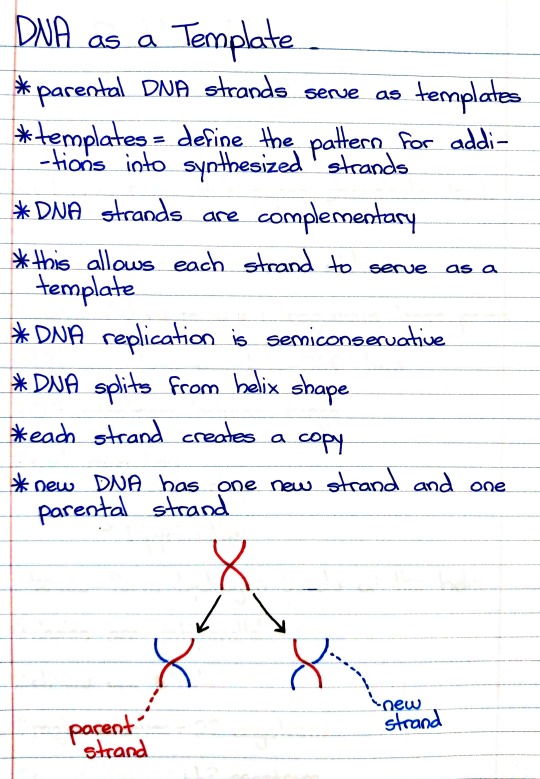
#studyblr#notes#my notes#genetics#genetics notes#dna replication#dna#dna notes#dna replication notes#notes on genetics#dna strands#strands of dna
4 notes
·
View notes
Text
Writing about this bullshit l a t e r
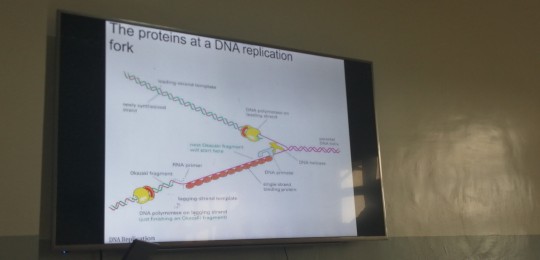
3 notes
·
View notes
Text
DNA Replication
Consists of creating an exact replicate of itself; each strand serves as a template for synthesizing a complementary strand; this replication process is semi-conservative. The new DNA has formed thanks to enzymes called DNA polymerases; this needs a primer synthesizing DNA from the 5' to 3' end. This process also includes other enzymes such as DNA ligase, DNA primase, DNA helicase, and topoisomerase, "this process takes us from one starting molecule to two "daughter" molecules, with each newly formed double helix containing one new and one old strand" (Clark, Douglas, Choi, 2018).
Let's talk about the differences between DNA replication in eukaryotes and prokaryotes. We could start by saying that prokaryotic organisms have circular chromosomes with a less extensive coiling structure than eukaryotic chromosomes. The replication process begins with a specific sequence of nucleotides called the origin of replication which has approximately 245 base pairs rich in AT sequences; the helicase is responsible for breaking the double helix in two and unwind the hydrogen bonds between the hydrogen base pairs, the ATP hydrolyzing process is necessary because requires energy.
This process requires three essential types of enzymes, DNA polymerase I, which acts later in the process. DNA
polymerase II is used to repair, and DNA polymerase III acts by providing new nucleotides one by one doing it in the 3' to 5' direction. "Topoisomerase binds at the region ahead of the replication fork to prevent supercoiling or over-winding" (Clark, Douglas, Choi, 2018).
On the other hand, we have replication in eukaryotes which although it starts in a similar way to prokaryotes, the process in eukaryotes has a pre-replication phase which contains proteins that initiate the process, "the leading strand is continuously synthesized by the enzyme pol δ, the lagging strand is synthesized by pol ε"
(Clark, Douglas, Choi, 2018). Here the genome is much larger than in prokaryotes, so the replication process is slower, making a ratio of 50 to 100 nucleotides per second; DNA polymerases have the names pol α, pol β, pol γ, pol δ, and pol ε.
Their DNA is packaged when chromatin fibers begin to condense around proteins called histones, which condense to form linear chromosomes. The end of which are called telomeres which are non-coding DNA sequences for a particular gene and protect the information from being deleted as the cell divides. A highly
regulated DNA replication process is found in eukaryotes and almost always involves extracellular signals to
coordinate specialized cell divisions in different tissues of multicellular organisms. Cyclins are synthesized
during the G1 process of the cell cycle, and external signals trigger their synthesis. To facilitate the synthesis of the S-phase proteins, DNA polymerases, and thymidylate synthesize, cyclins form complexes with cyclin-dependent kinases (CDK). The cells are primed for DNA replication during the S process by these complexes(Tabancay & Forsburg, 2006).
"In the final stage of DNA replication, the enzyme ligase joins the sugar-phosphate backbones at each nick site.
After ligase has connected all nicks, the new strand is one long continuous DNA strand, and the daughter DNA
molecule is complete" (DNA Replication in Eukaryotes, 2020). The environment in which they live; prokaryotes are not formed by cells, so they do not need complex machinery to function, however eukaryotes that are usually multicellular need a more complicated process because their requirements are higher, this is why more enzymes and fewer nucleotides are involved in eukaryotes and fewer enzymes and more nucleotides per second in each case.
References
Clark, M. A., Douglas, M., & Choi, J. (2018). Biology 2e. OpenStax.
DNA Replication in Eukaryotes. (2020, August 15). Retrieved March 2, 2021, from
https://chem.libretexts.org/@go/page/13293
OpenStax, Concepts of Biology. OpenStax CNX. May 18, 2016
http://cnx.org/contents/[email protected]:2ousESf0@5/DNA-Replication
Rye, C., Wise, R., Jurukovski, V., DeSaix, J., Choi, J., &; Av, Y. (2016). Biology. Houston, TX: Openstax.
Tabancay, A. P., & Forsburg, S. L. (2006). Eukaryotic dna replication in a chromatin context. Current Topics
in Developmental Biology, 129-184. doi:10.1016/s0070-2153(06)76005-7

3 notes
·
View notes
Text
DNA Replication
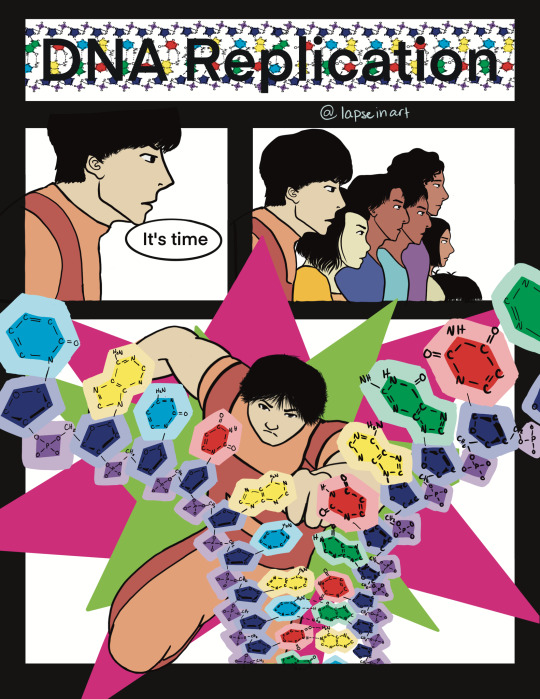
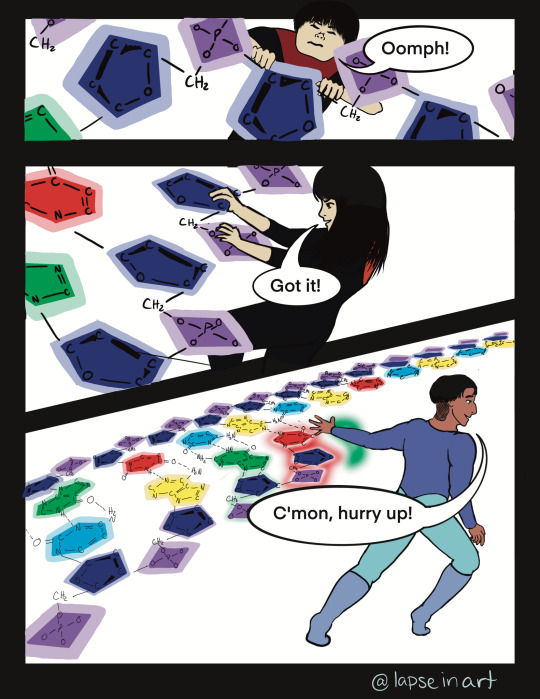
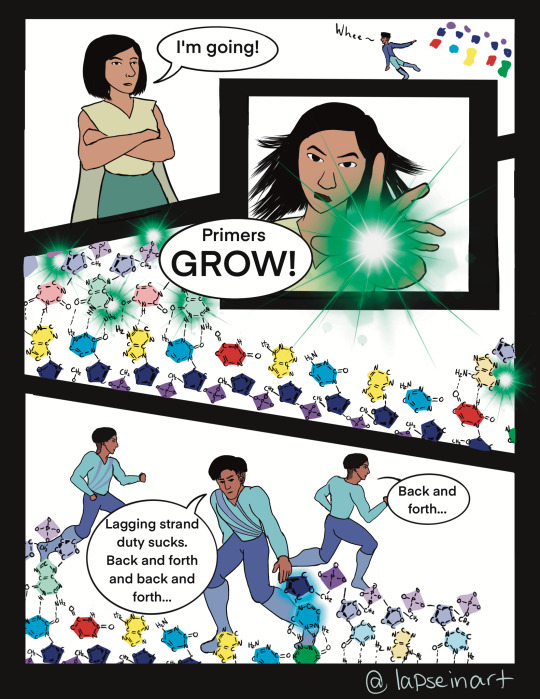

Anyway I think comics and stories are a good way to teach.
#i made this for my genetics class back in high school#i took the class because I didn’t want to do dissections#biology#genetics#original comic#comics#comic page#comic practice#dna#dna replication#superhero#cells at work#well inspired by cells at work#my teacher said no one went as hard on this assignment as I did#too lazy to shade#too lazy to fix it#education#lapse in art#comic
6 notes
·
View notes
Text
It is a dimeric protein that binds with exceptionally high affinity to duplex DNA at specific nucleotide sequences forming a termination complex that prevents further DNA replication.
"Chemistry" 2e - Blackman, A., Bottle, S., Schmid, S., Mocerino, M., Wille, U.
#book quote#chemistry#nonfiction#textbook#replication terminator protein#rtp#bacillus subtilis#dimeric#protein#chemical bonding#dna#deoxyribonucleic acid#nucleotide#dna replication#termination
0 notes
Text
Illuminating a critical step in initiating DNA replication in eukaryotes - Technology Org
New Post has been published on https://thedigitalinsider.com/illuminating-a-critical-step-in-initiating-dna-replication-in-eukaryotes-technology-org/
Illuminating a critical step in initiating DNA replication in eukaryotes - Technology Org
Brandt Eichman and Walter Chazin, professors of biochemistry, have worked together to better understand how DNA replication is initiated in eukaryotes. Using Vanderbilt’s state-of-the-art instrumentation in the Center for Structural Biology’s Cryo-Electron Microscopy Facility, Eichman, Chazin, and their colleagues provided detailed visualizations of a multi-functional protein in action, which sheds light on how DNA replication is initiated in humans.
Cryo-EM structures of polα–primase reveal a remarkable range of motion between two sub-complexes.
Eichman and Chazin shared reflections on this research, newly published in Nature Structural & Molecular Biology:
What issue does your research address?
We are interested in the molecular details of human DNA replication, one of the most fundamental processes of life; it is repeated millions of times each day as we make new cells. The new copies of DNA are synthesized by polymerases, which read the sequence of an existing DNA strand one nucleotide at a time and add the complementary nucleotide to the nascent DNA strand. Specific polymerases perform the bulk of DNA synthesis but cannot function without first having a short “primer” segment of the new strand.
This work addresses the molecular mechanisms of DNA polymerase α–primase (polα–primase), the enzyme responsible for synthesizing the primers. Polα–primase is an essential enzyme as it is the only polymerase that can initiate DNA synthesis by generating the primers that the other polymerases need to duplicate the genome.
Despite polα–primase being the first human polymerase discovered, the way it synthesizes very specific lengths of RNA and DNA in a single strand remained unclear for more than fifty years. How does it know that it has synthesized a specific number ofnucleotides of RNA before transitioning to DNA synthesis? How does it transition between the two modes? How does it know that it has synthesized a certain number of nucleotides of DNA before stopping?
Understanding the mechanisms behind polα–primase’s ability to “count” the length of the RNA and DNA segments of the primer is important because primers must be kept to a very short length, as they contain RNA in the new DNA strand and the DNA synthesized by polα is littered with mutations. Thus, the primers would be highly detrimental to the cell if they became a substantial part of the new DNA strand that persisted in the genome after replication.
To answer these outstanding questions, we used cryo-electron microscopy to capture snapshots of this multi-functional protein at various stages as it generates a primer. The high-resolution structures we determined illuminated the mechanisms of RNA and DNA counting by polα–primase. They also provide a starting point for design of novel small molecule modulators of polα–primase function that would provide new ways to investigate DNA replication in cells.
What was unique about your approach to the research?
The Eichman and Chazin labs have collaborated for many years to understand how polα–primase works. We visualized some of the first structures of polα–primase bound to nucleic acid substrates. It was the highly strategic design of primer/template substrates that allowed our team to “trap” the enzyme at several specific points along the pathway to synthesizing the primer. Importantly, this research was made possible by access to the state-of-the-art instrumentation in the CSB Cryo-Electron Microscopy Facility.
What were your findings?
Our data directly show that polα–primase holds on to one end of the primer throughout all stages of synthesis. This observation is critical to understanding how the initial RNA-primed template is handed off from the primase active site in one subunit (where RNA synthesis occurs) to the DNA polymerase active site in another subunit (where DNA synthesis occurs). The sustained attachment also serves to increase polα–primase’s ability to remain bound to the template and to regulate both RNA and DNA composition. Importantly, the detailed analysis of the structures revealed how flexibility within this four-subunit complex is critical to being able to synthesize the primer strand across two active sites.
In addition, our research suggests that termination of DNA synthesis is facilitated by reduction polα and primase affinities for the template as more DNA is synthesized.
What do you hope will be achieved with the research results?
We hope our research findings will illuminate to the field a more complete understanding of replication initiation and contribute to the growing understanding that complex molecular machinery requires flexibility and dynamics to function. The inherent flexibility within this complex, multi-subunit polymerase is essential to primer synthesis and to its ability to dynamically interact with multiple other enzymes present in the replisome (for the handoff of the primer to the replicative polymerase for bulk DNA synthesis, for example).
We also hope that this work will lead to a better understanding of how current polα–primase inhibitors work and more broadly pave the way for future designs of small molecule modulators to serve as tools for studying DNA replication in cells. Tool compounds of this type can also be used to evaluate the therapeutic potential of targeting specific replication proteins with roles in diseases of genome instability.
Source: Vanderbilt University
You can offer your link to a page which is relevant to the topic of this post.
#amp#Analysis#approach#Art#biochemistry#Biology#Biotechnology news#Capture#cell#Cells#Composition#cryo-electron microscopy#data#Design#details#Diseases#DNA#DNA replication#dynamics#electron#enzyme#enzymes#eukaryotic cells#Fundamental#Future#Genetic engineering news#genome#High-Resolution#how#human
0 notes
Text
What is Chromosome remodeling? Explained
Imagine a library with millions of books tightly bound together – that's kind of like DNA in chromosomes without remodeling. Remodeling acts like librarians carefully unstacking and organizing books to make them accessible to readers. Read more...
CHROMOSOME REMODELING
Chromosome remodeling is a vital process within cells that ensures the DNA instructions encoded in chromosomes can be accessed and used when needed. Imagine a library with millions of books tightly bound together – that’s kind of like DNA in chromosomes without remodeling. Remodeling acts like librarians carefully unstacking and organizing books to make them accessible to…

View On WordPress
0 notes
Text
You've heard of angels as machinery, but what about angels as molecular machinery? Proteins and the like. Imagine a topoisomerase angel unwinding the threads of fate, which are then split apart into multiple timelines by a helicase angel
1 note
·
View note
Video
youtube
Origin of Life: You Can't Trust Everything You Hear (Long Story Short, E...
0 notes
Text
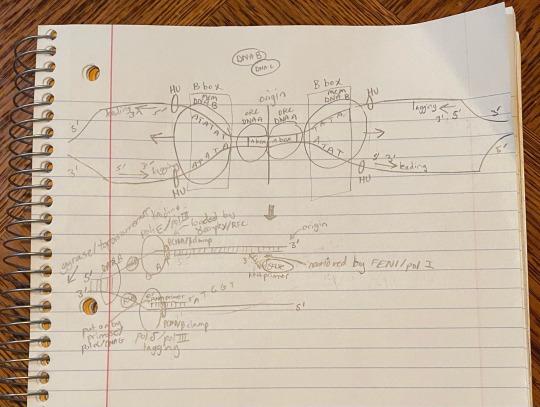

9/20/23
DNA replication is the single most complicated process I have ever encountered but I’m happy that it makes flowers possible.
#college#university#studyblr#studyinspo#studystudystudy#plants#studyspiration#flowers#dna replication#dna
1 note
·
View note
Text
packing my polish father into a cardboard box so that the enzyme knows where to bind on my dna
#biology#tata box#dna replication#polish moment#polish language#how do i make this reach the niche audience of english-speaking polish biology students
1 note
·
View note
Video
youtube
PCR - Polymerase Chain Reaction | Short Note | Arman Firoz
#youtube#PCR#polymerase chain reaction#research#biotechnology#DNA replication#DNA amplification#taq DNA polymerase#what is PCR
0 notes
Video
youtube
Sims2 Time Travel Machine: My family in Old Hollywood-1920s-30s Los Angeles
Simulated time travel via- The Sims 2 video game. Music by Mark Mothersbaugh. I recreated my great grandparents in the Sims 2! Then I had them have kids... and they came out looking just like my grandmother Millie and her brother Bob! See how close the DNA is! Maybe I should have made the sims eat more, lol. Tell me what you think! it's light and fun and moves fast! Great Sims 2 score by Mark Mothersbaugh. I wonder what he would think!? Another one of my "simulated time travel" films! This one will take you way back to the early 1900s! You get to watch a simulated version of the house my ancestors grew up in in downtown south east Los Angeles. The house is still standing! Maybe one of these days I will go see it. I would love to know what the inside looks like. And what kind of attic those stairs on the side lead to! Lewis Newman owned the house featured in the video. Unlike my similar auto-biographic film, "Life in Long Beach" I had no idea of the inside or the furnishings so I guessed! Not too many photos were taken indoors in those days! The film speed on those old cameras required full outdoor light! Mildred Newman was my Nana (grandmother) Millie who I developed a deep bond with. She told me next to nothing about her early years. And she never sat down and shared her photos with us. A lot of folks including her brother and mother, died young and I think she just wanted to forget. I got the photos after my dad died and have been digitizing ever since! But everyone looks so HAPPY! So this is a happy video! Featuring a great soundtrack of Sims 2 video game music by Mark Mothersbaugh. (Founder of the rock band Devo!) I don't mention it much in this one but my family was running from Pogroms and Nazis. That is why I am an American! And this video is about that period of time Lewis and his family got to enjoy the American dream! Lewis's family story is amazing and will be covered in a future episode. For now enjoy a good and simple time in their lives! This sweet story is dedicated to my great Aunt Rachel Rosenblatt. I wish she had come to the US too! Sadly she and her children and grandchildren stayed behind in Chortkov Poland. They never made it to the US and she and her daughter and her family were deported to and died in Auschwitz-Birkenau. Her sons made it to Israel however and I hope to find them and their descendants someday! #family #old #hollywood #angelenos #california #sims #sims2 #oldendays #1920s #flappers #children #grandparents #parents #simulator
#youtube#family#old school#old hollywood#old house#history#sims2#1920s#1900s aesthetic#children#mark mothersbaugh#video games#simulation#time travel#dna replication#ancestors#Jessica Chortkoff#jessica-chortkoff#jessimmersimqueen#los angeles#manual arts high#Old LA
0 notes
Text
The two prongs are called the leading strand and the lagging stand.

"Chemistry" 2e - Blackman, A., Bottle, S., Schmid, S., Mocerino, M., Wille, U.
0 notes